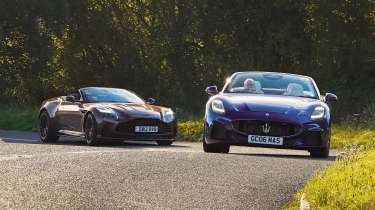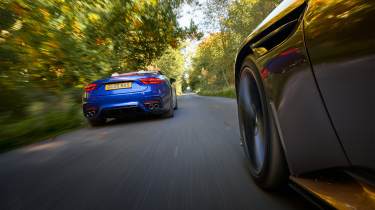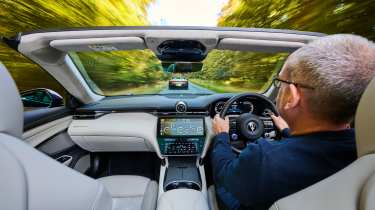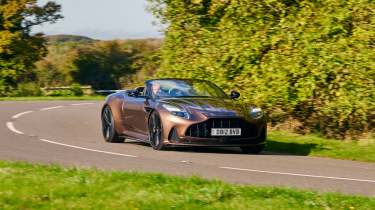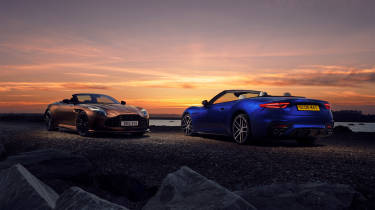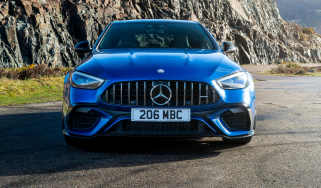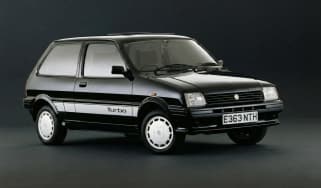Aston Martin DB12 Volante v Maserati GranCabrio Trofeo – open-top GTs go head-to-head
Maserati GranCabrio Trofeo or Aston Martin DB12 Volante? Two powerful and charismatic convertibles, but which is best? A cross-country drive to the coast should hold the answer
As the sun sets and the North Sea waves crash against the rocks and stone of the east coast beach, the products of two of the automotive world’s most storied companies sit silently having their picture taken. Their roofs are down, their jewel-like head and tail lamps twinkle in the dusk, their turbocharged motors are long cooled and all tick, tick, ticked out. After a full day shooting and several more days behind their respective wheels, the time has come to nail my colours: Aston Martin DB12 Volante or Maserati GranCabrio Trofeo?
The Maserati is your purer GT car, less frenetic than the DB12, which we’ve always felt a little hyperactive for a classic GT, if not quite sharp enough to be a super-sports car. The GranCabrio has a softer edge and also a power deficit of almost 130bhp, the Trofeo’s twin-turbocharged ‘Nettuno’ V6 producing 542bhp to the 671bhp of the DB12’s similarly boosted V8, though this isn’t the mismatch the bald figures might suggest.
The Italian motor feels quite old-school in how it delivers its performance, building strongly from low down, swelling through the mid-range and exploding to its peak. Unlike many of today’s large-lunged engines, it hasn’t been mapped to deliver everything in one big rush; rather it paints a broader picture of performance, while still leaving you in no doubt as to your progress and with a soundtrack to match your pace. What it lacks in cubic capacity and cylinder count, it makes up for with nuance and pedigree as it climbs towards its peaks.
More reviews
In comparison the DB12’s V8 feels feral. It races through the revs, feeling like it’s been set up to prioritise all-out pace above anything else. It’s certainly effective, and a visceral and exciting experience, the AMG-sourced engine breathing deeper and exhaling with a far stronger blast of performance than its Italian rival. Its gearchanges aren’t as in sync with the engine’s responses, though, lacking the silken synergy of the GranCabrio’s shifts. In the Aston, which has nine ratios to the Maserati’s eight, the changes feel too soft-edged and out of keeping with the rest of the dynamic package, whatever the drive mode. Odd, but consistent with the coupe we tested in issue 334.
On the subject of drive modes, I’m impressed by how energised the Maserati can feel in its most extreme Corsa mode, but even in Corsa the GranCabrio Trofeo can’t match the inherent performance edge of the Aston Martin in even its softest setting. Not that the DB12 does anything remotely soft (gearshifts aside). So the Maser is never able to match the fireworks of the Aston, which drops the Trofeo whenever the opportunity presents itself, its extra muscle very much apparent with every throttle opening, every upshift bringing another burst of energy. Even in its GT mode you’re reminded of the Brit’s unrelenting punch, and what it lacks in character and charisma in delivery compared with the smoother Italian six-cylinder, the V8 makes up for with its full-blooded performance.
You soon find yourself comparing each car’s performance with the way it looks: the smoother, cleaner lines of the GranCabrio reflective of how it performs against the clock with its less explosive character; the razor-edged, more muscular DB12 racing to performance benchmarks as its looks suggest. Spend more time with them and the Italian starts to fade into the DB12’s shadow, lacking any true Italian style and appearing quite generic parked next to the Aston. Canvas roofs closed, the Volante moves further ahead with a cohesiveness to the way it incorporates its fabric top, the GranCabrio in comparison looking a little uncomfortable, like a dad forced to wear a baseball cap.
The Maserati feels uncomfortable when you push it, too, again driving how it looks with a little too much mass for it to control. It’s generally responsive and you can keep your inputs clean and be rewarded with faithful obedience, but it doesn’t take much before you start to push the GranCabrio’s chassis out of its comfort zone. Underpinned by Maserati’s latest Skyhook air-suspension, the variable active dampers quickly run out of range, seemingly regardless of the suspension setting selected.
So even before you select Corsa, which lowers the body 15mm, as soon as you lift your pace and ask more of the chassis, the Maserati becomes unsettled, its underbelly running the gauntlet with the road surface beneath as it squeezes the air out of its springs. Just as with its coupe sibling, the GranCabrio feels more at ease playing the GT: wheel movements are less hyperactive within the arches, body control more measured. Even at a calmer pace you can run in Sport mode and lean on the increased tautness provided; it’s only when you raise your expectations and the pace too much that the Trofeo, like its coupe counterpart, can’t provide the answers you’d expect and possibly need.
Reining it back to its GT guise, and despite its 1895kg kerb weight and four-wheel drive, the Maserati is precise, almost delicate in many of its actions and reactions. Its steering is purer than you expect, and more linear too, while the four-wheel-drive transmission works away in the background, never corrupting feel or imposing its mass on the direction of travel. The steering remains largely corruption-free too, though there is some shake through the column when you put a significant load through it on a less than perfectly surfaced road. Actual deflection is seldom an issue, but the sensation can be a distraction.
The Aston feels more consistent, more together. Its fixed-rate springs and adaptive dampers lack the compliance of the Maserati and there’s a firmness to the ride even in the softest setting that detracts from its GT status. Just as its V8 gives an instant hit and constantly pushes you along at pace compared with the Maserati’s more measured – and charismatic – V6, so the DB12’s chassis is always on. It never truly relaxes, and remember this is meant to be Aston’s least extreme road car. But what it does give you is sports car levels of immediacy.
Its steering is more precise and alert in your hands, the car more agile and better equipped and set up to manage its mass. It gets in, through and out of any given corner with more clarity and sense of purpose, which encourages you to poke its V8 earlier and harder. While the Maser rarely feels like it actually needs its four-wheel drive and feels like it’s driving from the rear the majority of the time, the Aston reminds you all of the time that its 671bhp and 590lb ft has only the rear axle as a means of exit. It makes you more engaged with the car as you meter out your throttle inputs and balance the DB12, making for a more connected drive every time your focus is on pure performance rather than enjoying your surroundings.
Speaking of which, the Aston’s interior is far superior to the Maserati’s, regardless of the type of drive. You sit low in the DB12, surrounded by opulent leather and immaculate detailing and it feels that you’re in something rather special, whereas in the Maserati it feels like a volume manufacturer has had a go at making one of its cars feel posh. Which is kind of what Stellantis has done. You sit on the GranCabrio, perched on chairs that are wonderfully comfortable but lack support – not that the DB12’s are perfect, as the seat squab remains too short and unsupportive, a trait that afflicts all current Aston road cars. But the crucial difference is that the Aston makes you feel part of the car.
Neither has an infotainment system to write home about, the GranCabrio’s ergonomics also making little sense in terms of the placement of controls for such things as the roof, headlights and gearshift. Not that the Aston Martin enjoys a much better showing; its HMI is still fiddly and counter-intuitive to use on the move.
The Maserati is the quieter of the two, roof open or closed, the DB12 Volante hampered by the same tyre noise issues that the coupe suffers from, but the Aston feels more special to be in. That said, the Brit offers less interior space by a considerable margin, the rear seats being on a par with those of a Porsche 911 whereas the Maserati feels less like an exercise in torture when you fold yourself into the back. You’d have to really hate someone to ask them to sit in the back of the Volante with its roof closed.
You’d enjoy having access to either of these cars. However, the Maserati works better as the GranCoupe than it does the GranCabrio, which loses something of its sense of occasion and style when losing its fixed roof. As we found in our recent triple test that also included Bentley’s new Continental GT as well as the DB12 coupe, while the GranCoupe looks to blend the best of both British GTs into one desirable and stylish Italian package, it somehow misses the mark by small margins right across the board, and the same is true here. The DB12 Volante isn’t perfect either; it’s still too hyperactive to be a totally convincing GT, and in soft-top form its performance remit only shines a stronger light on its handful of shortcomings.
As our light has all but disappeared a long way west from our location, a decision needs to be made, not least because photographer Rich Pearce has a five-hour drive home ahead of him and web editor Ethan Jupp is close enough to home he can almost taste the beer. The DB12 gets the nod because it feels more connected and engaging more of the time, with that sense that every drive would have the potential to be a good one. And always ending with you taking a glance back as it cools down to a chorus of ticking hot metal.

